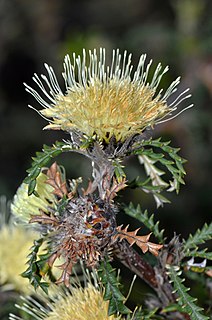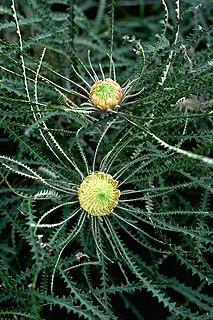
Banksia gardneri, commonly known as prostrate banksia, is a species of prostrate shrub that is endemic to Western Australia. It has pinnatipartite or serrated leaves, usually rusty brown flowers, and up to twenty-five elliptical follicles in each fruiting head. It occurs along the west part of the south coast of the state.

Banksia lanata is a species of shrub that is endemic to a restricted area of Western Australia. It has linear leaves, pale cream-coloured flowers in a head with whitish bracts at the base and later up to fifty elliptical follicles in each head.

Banksia arctotidis is a species of prostrate shrub that is endemic to the southwest of Western Australia. It has leaves that are pinnately divided to the midrib, cream-coloured flowers and hairy, egg-shaped fruit.

Banksia catoglypta is a species of shrub that is endemic to Western Australia. It has pinnatisect leaves with sharply-pointed, triangular lobes and heads of golden brown and cream-coloured flowers.
Banksia cypholoba is a species of dwarf, prostrate shrub that is endemic to Western Australia. It has pinnatipartite leaves with twenty-five to forty triangular lobes on each side, heads of about sixty brownish and yellow flowers and mostly glabrous follicles.
Banksia epimicta is a species of prostrate shrub that is endemic to a small area in the south-west of Western Australia. It has crowded, sharply pointed pinnatifid leaves, large heads of unpleasantly scented, creamy white and pale yellow flowers and a small number of follicles.
Banksia foliolata is a species of shrub that is endemic to Western Australia. It has hairy stems, pinnatifid leaves, heads of about sixty cream-coloured and maroon flowers and oblong to elliptical follicles. It grows on rocky slopes in dense shrubland in the Stirling Range National Park.
Banksia foliosissima is a species of erect shrub that is endemic to Western Australia. It has densely crowded, pinnatifid leaves, golden yellow flowers in heads of up to one hundred, and egg-shaped follicles. It is only known from two small areas in the south-west of the state.
Banksia fuscobractea, commonly known as the dark-bract banksia, is a species of shrub that is endemic to a small area in the south-west of Western Australia. It has prickly, serrated, wedge-shaped leaves, pale yellow and cream-coloured flowers in heads of up to almost two hundred, and three or four egg-shaped follicles in each head.

Banksia horrida, commonly known as prickly dryandra, is a species of shrub that is endemic to Western Australia. It has hairy stems, linear, pinnatifid leaves with sharply pointed teeth on the edges, up to sixty cream-coloured flowers in each head and hairy, egg-shaped follicles.
Banksia idiogenes is a species of tufted shrub that is endemic to Western Australia. It has hairy stems, deeply pinnatifid leaves, distinctive, scented, red and white flowers in heads of about eighty, later several glabrous, egg-shaped follicles in each head.
Banksia ionthocarpa is a species of shrub that is endemic to Western Australia. It has short, hairy, prostrate stems, pinnatifid leaves, pinkish purple to orange flower in heads of between forty and sixty at the base of leaves, and egg-shaped follicles with a distinctive tuft of hairs on the end.

Banksia kippistiana is a species of shrub that is endemic to Western Australia. It has linear, pinnatifid leaves with ten to twenty lobes on each side, heads of up to eighty yellow and cream-coloured flowers, and elliptical follicles.
Banksia lepidorhiza is a species of prostrate shrub that is endemic to Western Australia. It has underground stems, linear pinnatipartite leaves with sharply pointed lobes, pink, cream-coloured and yellow flowers in head of about thirty and egg-shaped follicles. It is only known from near Woodanilling.

Banksia mucronulata, commonly known as swordfish dryandra, is a species of shrub that is endemic to Western Australia. It has spreading, hairy stems, linear, deeply pinnatifid leaves with sharply-pointed lobes, pale yellow to cream-coloured flowers in heads of between 80 and 180, and egg-shaped follicles.
Banksia porrecta is a species of prostrate shrub that is endemic to the south-west of Western Australia. It has hairy, underground stems, pinnatipartite leaves with up to forty narrow triangular lobes on each side, yellow flowers in heads of between twenty and thirty, and one or two egg-shaped follicles in each head.
Banksia rufistylis is a species of column-shaped shrub that is endemic to Western Australia. It has linear leaves with sharply-pointed serrations, cream-coloured flowers with a red style arranged in heads of about forty, and egg-shaped follicles with a flattened tip.

Banksia serratuloides is a species of small shrub that is endemic to Western Australia. It has linear, pinnatipartite leaves, yellow and pink flowers in heads of about forty and hairy, wrinkled follicles.

Banksia stenoprion is a species of prostrate shrub that is endemic to the south-west of Western Australia. It has short, underground stems, pinnatisect leaves with triangular lobes, golden, mauve or purple flowers in heads of up to ninety, and egg-shaped follicles.
Banksia tortifolia is a small, spreading, prostrate shrub that is endemic to the southwest of Western Australia. It has short underground stems, pinnatipartite leaves with sharply-pointed, linear lobes on each side, greenish-cream, yellow and pink flowers in heads of about eighty, and glabrous, egg-shaped follicles.










